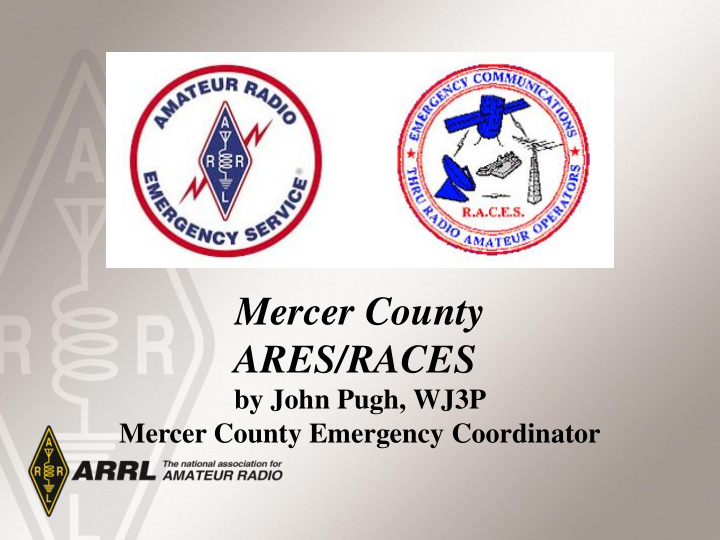



Mercer County ARES/RACES by John Pugh, WJ3P Mercer County Emergency Coordinator
Why are we here? The main reason why the FCC lets hams play with over $10 billion worth of radio spectrum instead of selling it off to commercial interests is because we are prepared to supply Emergency Communications when needed. Explain how the ARRL organizes local ham radio operators to provide emergency communications services in our area, in cooperation with the Mercer County Office of Emergency Management, the American Red Cross, and the National Weather Service. How can you be prepared and get involved with such efforts.
ARES/RACES • Amateur Radio Emergency Service (ARES). – Organization that supports other agencies. – Local and regional in scope, affiliated with the ARRL • Radio Amateur Civil Emergency Service (RACES) – FCC Radio Service that might replace regular Amateur Radio Service in a National Emergency – Requires pre-registration with government Emergency agency
Mercer County ARES/RACES. – One combined organization. – Supports Mercer County OEM, NWS Skywarn, American Red Cross. – Headed by ARRL County Emergency Coordinator (EC), who is also designated the County RACES Officer by Mercer County OEM. – Assistant EC’s for EOC, Red Cross & Skywarn – County EC reports to ARRL Section EC → to the Section Manager → to ARRL HQ. – Data is gathered to support our operations to the FCC
Mercer County ARES/RACES. – We operate two fixed stations: – W2MER at Dempster Fire Academy – N2ARC at American Red Cross, Princeton – ARES members must become familiar with the operation of each station! – Station equipment testing and member training takes place monthly – on the last Monday night of each month (except May and December)
Nets • Primary means of operation for emergency communications • Social Nets – Pepper Net, club nets • Traffic Nets – Pass Radiogram messages, a key skill for emergency operators • Training Nets - Periodic testing of equipment, pass news and other information Mercer ARES net Thursday before the last Monday of the month, W2MER 147.105/R
Nets • Emergency and Public Service Nets – The real thing! • Support Operations to help people • Activation when called upon by our served agencies • Frequently we activate Skywarn Nets on the N2RE 146.460/R (David Sarnoff Radio Club) • Support events as Walk-a-thon, parades, triathlon, etc. (usually club functions)
Net Structure • Net Control Station (NCS). – Traffic cop that controls the flow of information. • Directed Nets • Check-in and check-out procedures. • Communications discipline is vital. – Learn and follow procedures. – Speak only when directed, and only to whom directed. – Follow through with your commitments.
Emergency Communications • Our purpose is to pass messages and information • “Traffic” refers to messages that are relayed via ham radio. • National Traffic System (NTS) uses a formal structure to ensure accuracy – – Procedures – Accountability
Incident Command System (ICS) Form 213
Tactical Communications • Less formal than radiogram or ICS messages, sometimes called an open net • Tactical Call Signs are used – Facilitate communications. – Location or function specific: “EOC” “Shelter” “Main St. Command” – Transcend operator changes. • FCC ID rules still apply.
Tactical Communications – Initiate the conversation with tactical call; end the conservation with FCC callsign – Role play: EOC is W2MER and ARES member WJ3P is at Shelter 1 • “EOC, this is Shelter 1, Over” • “Shelter 1, this is EOC, Over” • “EOC, Shelter 1 needs 50 more cots, Over” • “Shelter 1, expect 50 cots in 30 minutes, Over” • “EOC, thanks! Shelter 1, WJ3P, Out” • “W2MER, Out”
Emergency Equipment • Most activations require you to be deployed to an EOC, shelter, or other location where comms are needed. • Skywarn is an exception, you can stay at home! • If you are not assigned to a fixed station, you might be using your own equipment.
Emergency Equipment • Develop a personal “Go - kit” – Ham radio equipment, typically two meters. – HT, mobile, or portable – Emergency power sources, extra batteries – Personal survival supplies and equipment. • ARRL Go-Kit Checklist • Mercer ARES Reference Card
EMCOMM Tips • Don’t become part of the problem! • Know your abilities and limitations-keep yourself safe. • You are a communicator, not a decision or policy maker! • Don’t give out unauthorized information or opinions • Follow radio discipline and net procedures – avoid idle chatter • Protect personal information; ham radio communications is a “party line”, anyone can be listening.
EMCOMM Training • If you are going to participate in ARES/RACES, get training. • Info at ARRL web site (http://www.arrl.org/ares) • ARRL Field Service Manual • ARES Manual • Take EMCOMM courses. – FEMA Training courses at training. fema.gov/EMIweb/IS/ – ICS- 100 “Intro to Incident Command System” – IS- 700 “National Incident Management System (NIMS), An Introduction” – ARRL EMCOMM Courses 1, 2, and 3.
EMCOMM Training • Actively participate in activities. – Register with your ARRL County Emergency Coordinator. – Participate in Public Service activities. – Attend community meetings and get involved in your community.
Mercer County ARES/RACES • Questions and Answers • YOUR NEXT STEPS: • Complete ARES Registration Form • Pick up handouts: • Reference Card • Go-kit Checklist • Join us monthly on our Thursday net and at our Monday station tests.
Mercer County ARES/RACES by John Pugh, WJ3P Mercer County Emergency Coordinator
Recommend
More recommend